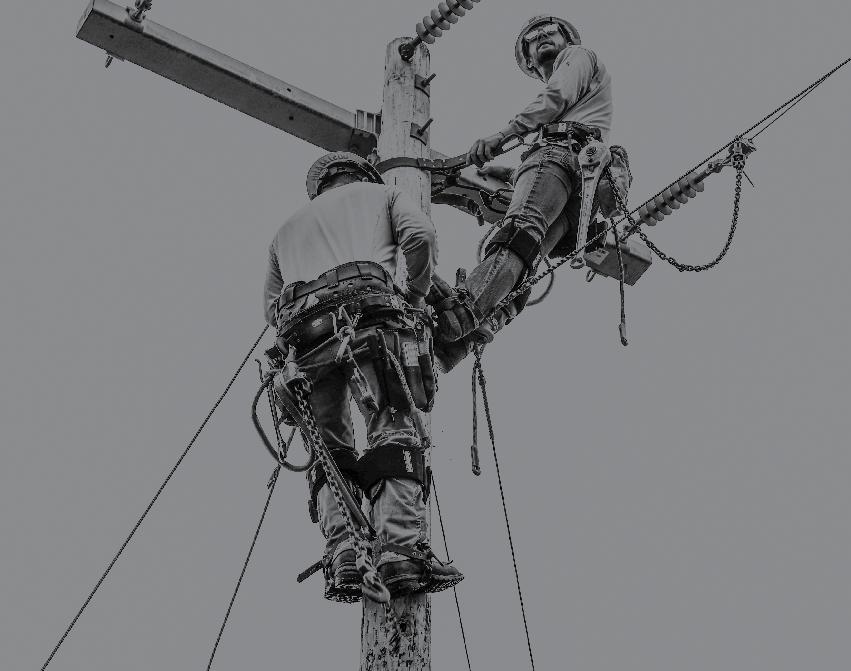







SEAFOOD’S COASTAL HISTORY


PICTURE THIS: SWEET TREATS

SOURDOUGH IN THE SPRING
















Before long, it will be summertime and thousands of children will be flocking to summer camp and taking part in canoe races, softball games, swimming, and fellowship. Unfortunately, not all children are able to have this type of experience. Those with special needs — medical, physical, or mental — cannot enjoy the same summertime fun as other children. Lucky for these children there was a woman who had a dream and a vision of a place where these special needs children could go and enjoy camp life and still get the medical attention they need. This woman was Mary Kitchens and her dream and vision has now become a reality.
Camp Kamassa is Mississippi’s only year-round, fully handicap-accessible camp for children and adults with chronic illness, physical and intellectual challenges, and other special needs. The name, “Kamassa” (pronounced Kuh-MAH-suh), comes from the Choctaw language and means “toughness; to persevere under di culties and not give up.” How appropriate considering the campers and families who will use this facility.
I first learned of Camp Kamassa from Southwest Electric CEO Kevin Bonds. The camp is in Southwest Electric’s service territory and Southwest, its board, and employees have been big supporters. Kevin brought the camp to the attention of the Electric Cooperatives of Mississippi’s board of directors and co-ops from all over Mississippi have supported Camp Kamassa over the last seven years.
While I have been supporter of the camp and participated in fundraising events, I had never seen the place until March 7. Deb McGee, the human resources and public relations specialist for Southwest, invited me down for a visit. “Southwest employees are going to have a workday that Friday,” Deb said.
“It would be a great time for you to finally visit, and don’t worry, no one expects you to work.” That last part stung a little, but I realized she was referencing my cane, as I am still recovering from back surgery, and not my lack of skill or talent.
Tanya Mohawk, the executive director, gave me a golfcart tour of the facility and showed me around. I visited a huge activity center, where children will be able to experience woodworking, pottery, needle working, and even a performance room for plays or skits. Of course there are rooms for the campers, all wheelchair accessible, and even family cabins. There is a medical clinic, so children can continue to receive the medical treatment they need while attending camp. The magnificent zero entry swimming pool was gorgeous. Even the floating pier on the lake has runners to hold the canoe steady while campers take their seat. The camp was much more impressive than I had originally imagined.
Camp Kamassa will open to its first campers in mid-May. However, the work is not completed. Mary and Tanya still have some big plans, and they need support to finish Camp Kamassa. Please read our cover story and consider giving to help finish this wonderful facility. No amount is too small, and all donations will be appreciated. Camp Kamassa will be an incredible miracle for Mississippi’s toughest kids.

by Michael Callahan
Executive Vice President/CEO Electric Cooperatives of Mississippi



Sipp & Savor
The MAX April 12
Threefoot Festival
Downtown Meridian April 18–19
Earth’s Bounty + First Saturday
The MAX • May 3
Bud N’ Boilin’ Singing Brakeman Park May 3


Meridian Symphony
Beethoven & Blue Jeans
MSU Riley Center • May 3
Jimmie Rodgers Music Festival
Downtown Meridian • May 12–18

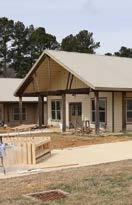



The Official Publication of the Electric Cooperatives of Mississippi
Vol. 78 No. 04
OFFICERS
Brian Hughey - President
Brian Long - First Vice President
Shawn Edmondson - Second Vice President
Brian Clark - Secretary/Treasurer
Michael Callahan - Executive Vice President/CEO
EDITORIAL STAFF
Lydia Walters - VP, Communications
Steven Ward - Editor
Chad Calcote - Creative Director
Kevin Wood - Graphic Designer
Alan Burnitt - Graphic Designer
Jill Sowell - Graphic Designer
Courtney Warren - Graphic Designer
Chris Alexander - Member Services Coordinator
Andy Tuccio - Media Solutions Director
Steve Temple - Social Media Director
EDITORIAL OFFICE & ADVERTISING
601-605-8600
Acceptance of advertising by Today in Mississippi does not imply endorsement of the advertised product or services by the publisher or Mississippi’s electric power associations. Product satisfaction and delivery responsibility lie solely with the advertiser.
• National advertising representative:
American MainStreet Publications, 800-626-1181
Circulation of this issue: 474,944
Non-member subscription price: $9.50 per year.
Today in Mississippi (ISSN 1052-2433) is published 12 times a year by Electric Cooperatives of Mississippi Inc., P.O. Box 3300, Ridgeland, MS 39158-3300, or 665 Highland Colony Parkway, Ridgeland, MS 39157. Phone 601-605-8600. Periodical postage paid at Ridgeland, MS, and additional o ce. The publisher (and/or its agent) reserves the right to refuse or edit all advertising. The magazine is published for members of subscribing co-ops. The magazine is a bene t of membership.

POSTMASTER: Send all UAA to CFS. (See DMM 507.1.5.2) NON-POSTAL AND MILITARY FACILITIES: send address corrections to: Today in Mississippi, P.O. Box 3300, Ridgeland, MS 39158-3300 www.facebook.com/TodayinMississippi www.todayinmississippi.com

Camp Kamassa and Mississippi’s Toughest Kids Foundation founder Mary Kitchens at the camp. Photo by Chad Calcote.
High school juniors from all over the state descended on Jackson Feb. 26 to Feb. 28 to participate in the 38th Electric Cooperatives of Mississippi Cooperative Leaders Workshop.
The conference, held at The Westin in downtown Jackson, gave 84 high school students this year to learn about leadership, community service, and state government in action.
Each student was sponsored and chosen by di erent electric cooperatives throughout the state.
The students also earned an all-expense paid group trip to Washington, D.C. in June.
During the three-day workshop, students met with their state lawmakers, toured the state capitol, participated in problem solving activities, and attended speeches by motivational speakers.
Lt. Gov. Delbert Hosemann and Secretary of State Michael Watson spoke to the students during the event.

Mississippi electric co-op general managers, communicators, and linemen spent Feb. 20 at the state capitol in Jackson celebrating Cooperative Day.
The event promoted the important relationship between Mississippi legislators and electric co-ops, which provide electric power and high-speed internet to rural Mississippians.

The co-ops set up booths and demonstrations. Key sta from the co-ops visited with lawmakers during the event to talk about the state’s important relationship with cooperatives and how their partnership works to better local communities.
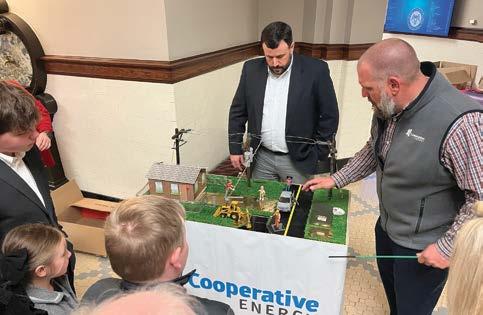











I am always on the lookout for plants that produce nutritious fruits and berries, and during a recent visit to a local nursery, I was drawn to some goji berry plants.
These fascinating plants are native to Asia. They have been cultivated for centuries for their highly nutritious fruit and medicinal properties. Their ability to thrive in a variety of conditions makes them an excellent addition to gardens, o ering ornamental beauty and a bountiful harvest.
Growing as a sprawling, arching shrub, the goji berry plant matures to 6-10 feet tall and wide, forming a graceful, fountain-like shape. Its long, flexible branches are sometimes thorny and adorned with soft, lance-shaped gray-green leaves.
In late spring to early summer, clusters of small, bell-shaped purple flowers appear, attracting pollinators like bees and butterflies. These blossoms give way to small, oblong berries that ripen from green to a brilliant red orange.
Goji berries thrive in U.S. Department of Agriculture hardiness zones 5-9, making them ideal for Mississippi. This plant is incredibly resilient, tolerating both heat and drought once established. It prefers full sun for maximum fruit production, but it can adapt to light shade.
I recommend planting in well-draining soil with a slightly alkaline to neutral pH of 6.5-7.0. It grows well in sandy, loamy, or slightly clay-heavy soils.
With its graceful arching habit, brilliant flowers and nutrient-rich fruit, the goji berry plant makes a productive and ornamental addition to the garden. Grow yours as a landscape shrub, train it on a trellis or keep it in a container.
Their glossy, thin skin encases a soft, juicy interior fruit. Goji berries have a unique flavor that blends sweetness, tartness, and subtle earthy notes.
Before planting, choose a sunny location with good air circulation to promote healthy growth and minimize disease risks. If the soil is compacted, amend with compost or sand to improve drainage. Young plants require regular watering to establish strong roots. Once mature, they are quite drought tolerant. Water deeply but allow the soil to dry slightly between waterings to prevent root rot. Feed your plant with a balanced fertilizer in early spring to encourage vigorous growth and fruiting. Its nutritional needs are similar to that of tomatoes.
Since goji berries produce fruit on new wood, I recommend pruning in late winter or early spring to remove weak or dead growth and encourage better fruiting. Goji berry plants begin flowering in late







spring to early summer, and the fruit ripens from late summer to early fall. Harvest by hand to avoid bruising the delicate berries.
I enjoy eating the berries fresh at peak ripeness, but they are also excellent dried. This concentrates their natural sweetness and extends their shelf life.
With its graceful arching habit, brilliant flowers, and nutrient-rich fruit, the goji berry plant makes a productive and ornamental addition to the garden. Grow yours as a landscape shrub, train it on a trellis, or keep it in a container.
However it is used, the goji berry plant provides a rewarding harvest while adding beauty to your outdoor space.

by Dr. Eddie Smith
Southern Gardening columnist Dr. Eddie Smith, a gardening specialist and Pearl River County coordinator with the Mississippi State University Extension Service, is an internationally certified arborist, Produce Safety Alliance certified trainer, and one of the developers of the Mississippi Smart Landscapes program that encourages the use of native plants in the landscape.
























Most people catch flounder while fishing for redfish, speckled trout, or something else, but these odd fish can provide great sport and delicious meals, particularly when stu ed with Gulf Coast crabs.
Southern flounder, the most common in Mississippi waters, show irregular white splotches on their brown sides. They average about one to three pounds, but Karen A. Good set the state record with a 10-pound, 4.66-ounce fish.
Twice each year, flounder migrate from the bays and estuaries to the Gulf of Mexico and back, although some flounder stay in inshore waters all year long. As waters cool in the fall, most flounder head to the deep
waters of the gulf where they spawn and spend the winter. In the spring they return to inshore waters.
When flounder return to the bays, marshes and estuaries in about April, look for them along shallow weedy shorelines. Focus on little coves or grassy pockets where they can use their superior camouflage to hide from prey. They frequently bury themselves in silt with only their eyes protruding to look into the tidal flow. They wait to ambush anything irresistible that flows over them. Then, they explode from their lair to snatch it.

A live shrimp under a float o ers a great way to catch flounder. Toss it along a weedy shoreline and let the current carry the bait naturally. Occasionally, pop the cork to make a surface commotion that mimics a fish striking bait. Live minnows also make great flounder baits, either fished under a cork or on the bottom. Flounder might also hit other natural baits.
“Live bull minnows are one of the best flounder baits around,” Mike Adams with Goin’ Coastal Charters (228-697-4808, goincoastalcharters.com) in Ocean Springs said. “Throw it close to the points or any marsh grass and work it slowly back to the boat by just dragging it on the bottom.”

Most Mississippi sportsmen fish for flounder with natural baits. However, flatfish sometimes strike artificial temptations that imitate shrimp or small baitfish. Anything that might entice a speckled trout or redfish could interest a flounder.


The shorelines along Bayou Caddy and Heron Bay are tough to beat for flounder. The marshes in the back of Bay St. Louis are great places to fish. Even in the bays, some of the pilings in the marinas and under the bridges can hold flounder.
Mississippi anglers might catch flounder all along the coast from the river deltas to the barrier islands. Flounder even venture into fresh water and regularly appear in streams miles from the coast. Many people fish the marshes from Bayou Caddy near Waveland to the Pearl River delta.

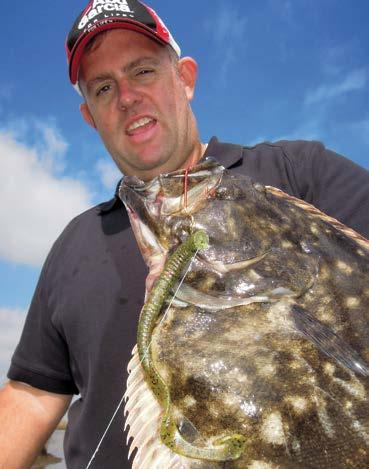
“The shorelines along Bayou Caddy and Heron Bay are tough to beat for flounder,” Sonny Schindler with Shore Thing Fishing Charters (228-342-2206, shorethingcharters.com) in Bay St. Louis said. “The marshes in the back of Bay St. Louis are great places to fish. Even in the bays, some of the pilings in the marinas and under the bridges can hold flounder.”
Farther east, several rivers flow into Back Bay, also called Biloxi Bay. Grassy islands and flats in the bay often attract flounder. The marshes by Old Fort Bayou near Ocean Springs can also produce good flounder action. The Pascagoula River also creates a rich delta that holds flounder.

by John N. Felsher
John N. Felsher is a professional freelance writer, broadcaster, photographer, and editor who lives in Alabama. An avid sportsman, he’s written more than 3,300 articles for more than 170 different magazines on a wide variety of outdoors topics. Contact him at j.felsher@hotmail.com.













by John N. Felsher
Built on a peninsula and founded from the sea by the French more than 300 years ago, Biloxi always enjoyed a special relationship with the water and the seafood it produced. The Mississippi Maritime and Seafood Industry Museum preserves the memory of that legacy, focusing heavily upon the seafood industry.
“The sea has been instrumental in the development of Biloxi since the beginning,” Elizabeth Alexander, the museum’s education and outreach coordinator, said. “In the 1800s, Biloxi was just a sleepy little fishing village. People caught the seafood and brought it to their dinner tables. By 1900, the people realized that the Biloxi area had enough seafood to share with the world.”
Established in 1986 at 115 1st Street in Biloxi, the museum exhibits many artifacts and interpretations of the vibrant maritime history and heritage of the Mississippi Coast. In 2005, Hurricane Katrina destroyed the museum, but a new 20,000-square-foot three-story museum opened in 2014.
“When people first enter the lobby, they see the beautiful Fresnel lens from the old Ship Island Lighthouse,” Alexander said. “We also have a Laitram automatic shrimp pealing machine, invented by 16-year-old J.M. LaPeyre. Before then, people had to peel shrimp by hand. We also have artifacts from the ‘U.S.S. Biloxi,’ a World War II cruiser, and many other things.”
Alexander’s great-great grandfather, Lazaro Lopez, became one of the people most instrumental in turning seafood into an industry in Mississippi by establishing the first seafood processing plant in the area. Many people from di erent cultures speaking various languages participated in catching, processing and shipping Mississippi seafood.
“Other cities might be a ‘melting pot,’ but we’re a ‘gumbo pot,’” Alexander said. “We have a new Vietnamese exhibit to recognize their contributions to the seafood industry. The Mississippi seafood industry has an annual economic impact of more than $377 million and provides employment for over 8,500 people. Back in the day, oysters were the huge player, but shrimp is king now.”
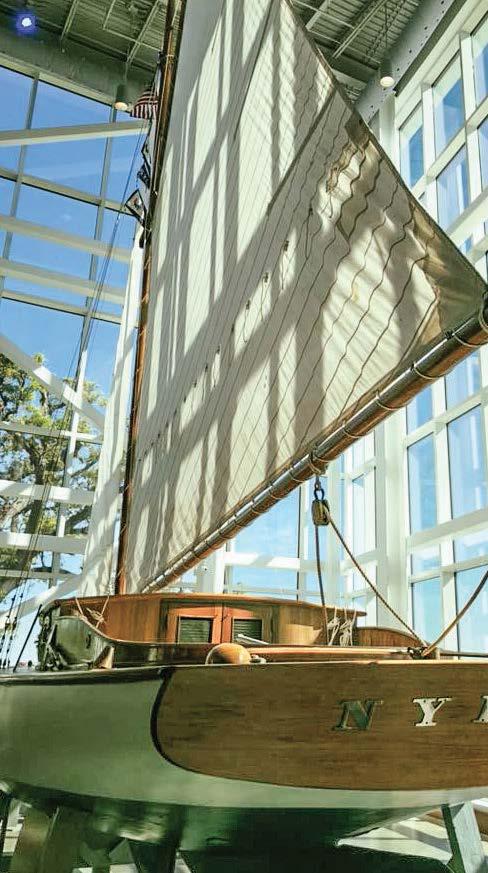




Of course, people venturing out to sea need boats. Once called the “White Winged Queens of the Gulf of Mexico,” Biloxi schooners harvested seafood and performed many other functions. These agile sailing craft built locally from Mississippi and Louisiana timber, began as oyster harvesting boats in the late 19th century. Their heyday lasted about four decades.
“Biloxi schooners were the worker bees of the seafood industry for a long time,” Alexander said. “Unfortunately, no original Biloxi schooners still exist, but we own two replicas, the ‘Glenn L. Swetman’ and the ‘Mike Sekul.’ People can charter them or take tours and experience how to sail. The princess of the show, the ‘Nydia,’ a sandbagger sloop built in 1898 about six blocks from the museum, sits in our main gallery.”

Youngsters can sail aboard a Biloxi schooner to one of the barrier islands. In other programs, campers can participate in things such as shrimping and fishing.
“Every summer, we hold a Sea-n-Sail Adventure Camp for children six to 12 years old.” Alexander said. “We teach them about the history of this area and do hands-on activities, like sailing on a Biloxi schooner, how to fish and catch shrimp. Also, Grayhawk Perkins of the Choctaw and Houma Tribes shares his Native American lore. We also hold private events, such as weddings and parties.”
Each May, the museum holds the Billy Creel Memorial Wooden Boat Show. At the largest gathering of boats on the Mississippi Coast, people can see and tour historic, antique, and other wooden craft. The 2025 show will be held May 17-18 at 367 Beach Blvd. in Biloxi.
For more information on the museum, call 228-435-6320 or visit maritimemuseum.org.



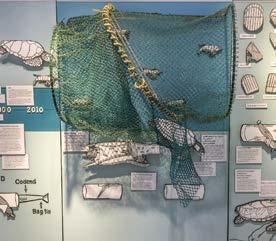



































Send us a photo of your children, grandchildren, or kids in your family playing outside. The photos must be high-resolution JPG files of at least 1 MB in size. Please send the photo as an attachment to an email and send it to news@ecm.coop. Each entry must be accompanied by photographer or sender’s name, address, and co-op.
SUBMISSION DEADLINE: MAY 30. Select photos will appear in the July 2025 issue.






























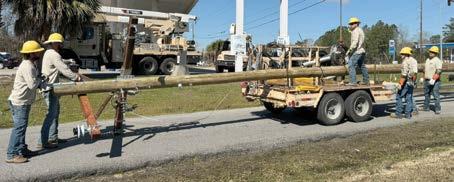
With April being National Lineman Appreciation Month, we recognize this unique group of employees who take immense pride in their profession. Line workers are highly skilled and encounter some of the most challenging work conditions, often working in rain, wind, extreme heat and cold, in the dark, and on the side of the road next to fastmoving tra c. Safety is a lineman’s primary focus, as his life and the lives of those who work with him depend on it. Daily, Singing River Electric linemen work with an element of danger that requires constant concentration, with no margin for error.
Singing River Electric linemen go through years of extensive training to





achieve journeyman status. For many, that training started before they arrived at Singing River Electric. Our 25-year partnership with Mississippi Gulf Coast Community College has proven to be invaluable in hiring individuals who have succeeded in both the classroom and in the field to become apprentice linemen and allows for a seamless transition of these new linemen into the workforces of Singing River Electric, other electric cooperatives, and electric contractors.
This month we honor Singing River Electric linemen and all linemen across our great nation for their strength of character and love of family, community, and country. We are grateful for our linemen and all our employees, as well as the families who support them.
by Brian Hughey





















Lower your energy use in the laundry room by washing clothes with cold water whenever possible, as heating water accounts for most of the energy used in a laundry cycle. Wash full loads and use high-e ciency detergent designed for cold washes.
For drying cycles, clean the lint filter before each load to improve airflow and use dryer balls to reduce drying time.
To help spread out your energy demand, wash and dry clothes late in the evening, when other appliances are less likely to be running. This will help control unwanted dryer heat and the demand portion of your electric bill.
Contractors are or will soon begin clearing trees, limbs, and underbrush around and below the power lines on these streets and surrounding areas to help decrease the number of power outages and reduce the risk of coming in contact with the lines.
Forts Lake Substation – Forts Lake Road, Constitution Road, Highway 90, Presley’s Outing Road
Monaco Lake Substation – Old Mobile Highway, Industrial Road, Highway 90
Aleco Substation – Highway 57, Wire Road, Highway 15, Old Biloxi Road
Dickerson Sawmill Substation – Old Highway 63, Highway 63, Brushy Creek Road
Agricola Substation – Highway 613, Barton Agricola Road, Highway 612

In 1999, now retired Singing River Electric General Manager and CEO Lee Hedegaard saw the need to attract and retain qualified linemen since many were reaching retirement age, and our membership was growing. His goal was to develop a workforce for the future – not just for Singing River Electric but for the industry as a whole.
Thanks to Hedegaard’s vision, Singing River Electric partnered with Mississippi Gulf Coast Community College to create an apprentice electric lineman program at the George County Center. The first class began in August 1999, and Singing River Electric hired the first of many lineman school graduates in December 1999.
“The establishment of the Electrical Lineman Training School will enable us to develop a qualified pool of applicants,” said Hedegaard in 1999 when the program began. “This will not only benefit Singing River Electric and other utilities, but also our customers as having qualified, trained employees adds value to the service they receive.”
The apprentice electric lineman program marked its 25th anniversary with the Fall 2024 class.
Over the past 25 years, 135 linemen have been hired by Singing River Electric, with others hired by fellow Mississippi electric cooperatives and contractors. The program provides a strong foundation with students learning about basic electricity, OSHA regulations, equipment, safety, and other necessary training to begin work in this industry.
Eight graduates of the first lineman school class currently work at Singing River Electric in a variety of roles.
Many Singing River Electric employees and retirees served as instructors for the lineman school over the years, notably the late H.L. Ivey, the late Buck Williams, and current instructors David Eubanks and Russell Fairley.
“This program opened a door for me to get into line work” said SRE Safety Manager Jason Havard. “The class continues to improve and evolve, but even after 25 years, many things are done the same way – apprentice linemen hired have a good foundation in safety and several certifications that prepare them for their new career.”
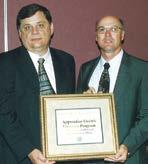
MGCCC’s apprentice electric lineman program received recognition from the Mississippi Public Education Forum in 2001. Pictured are program founders retired Singing River Electric General Manager Lee Hedegaard (left) and Magnolia Electric Power Chief Engineering and Operations Manager Aaron Achord; Achord worked for contractor Red Simpson at the time.
“On day one of being hired, the apprentice linemen are ready to work with general knowledge and capabilities,” said Field Representative James Daughtery who supervises SRE overhead line crews. “Already having their CDL license and hours logged to achieve climbing and other certifications lets them immediately start getting on-the-job line work experience.”

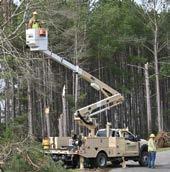
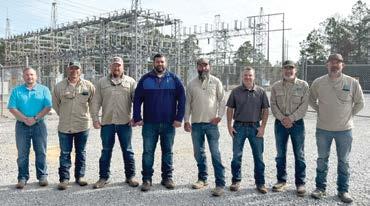
Thirteen Singing River Electric linemen worked in Wayne County’s Beat Four area after a tornado touched down and broke more than 70 poles in Dixie Electric’s service area on Feb. 12. Changing out that many poles and restringing the power lines was long, tedious work that our linemen performed until power restoration was complete. Through Cooperative Principle No. 6: Cooperation Among Cooperatives, electric cooperatives come together to assist with power restoration efforts.





Singing River Connect now has two places with free Wi-Fi access for the public.
Lum Cumbest Park in Hurley • George County High School baseball field
Signs with QR codes are placed throughout Lum Cumbest Park and the George County High School baseball field, allowing visitors to download a profile and access Singing River Connect SmartTown Wi-Fi for free.
Visitors can roam freely and stay connected while attending sporting events and other activities.
Singing River Connect subscribers enjoy the same great Wi-Fi service they have at home, and those who are not subscribers can see just how fast fiber internet is. See the difference having a trusted, local provider makes. We appreciate our partnerships with Jackson County and George County High School Baseball to provide this service.
Singing River Connect representatives Taylor Switzer, Raven Pipkins, and Karli Pilkington assisted George County High School baseball game attendees with accessing free Wi-Fi and provided the local customer service that sets Singing River Connect apart.

APRIL 2025
Get blazing-fast fiber internet from local people you trust.
Step 2: Make-Ready Construction
Replacing, upgrading, and installing poles to allow for fiber lines
• Bayou Cassotte
Step 3: Fiber Construction
Running fiber lines on poles and burying lines underground
• Kreole
• Monaco Lake
• Singing River Mall
• Gautier
• Fountainbleu
• Hamill Farm
• Ocean Springs
• Gulf Park Estates
• Sunplex • Fort Bayou
Thank you to our Singing River Connect subscribers who completed our email survey! We appreciate the feedback and are using it to shape how we continue bringing our subscribers the best fiber internet service and customer service possible.
Congratulations to our residential and business survey drawing winners!
Janice G.
Jarrod F.
Phillip J.
Hurley United Methodist Church
Donald Bunch
Lott Family LLC
Step 4: Splicing
Connecting fiber lines to the network
• St. Martin
• Martin Blu
• Hickory Hills
Step 5: Service Drop & Drop
Splicing & Step 6: Installation
Bringing mainline fiber to the exterior of your home and connecting your home to blazing-fast fiber internet
• Tucker Road
• Forts Lake
• Helena
• Helena Industrial
• Escatawpa South
• All previously opened areas












A group of 84 high school juniors from all over the state gathered in Jackson on February 26-28 for the 38th Electric Cooperatives of Mississippi Cooperative Leaders Workshop.

This program instills leadership skills, inspires creative thinking, encourages community service, and introduces students to legislative elected o cials from their communities.


Singing River Electric representatives Camila Cristobal from George County High School, Aliya Douglas from St. Martin High School, and Brett Jackson from East Central High School met with their state lawmakers, toured the state capitol, participated in leadership and problem-solving activities, and listened to speeches from Lt. Gov. Delbert Hosemann, Secretary of State Michael Watson, and political cartoonist Marshall Ramsey.
Camila, Aliya, and Brett earned the trip to the workshop following a competitive selection process in the fall during Singing River Electric’s Cooperative University event. They will travel to Washington, D.C. in June for a seven-day youth leadership tour.

A. Camila, Brett, and Aliva smiled for the camera in front of the Capitol. B. (From left to right) Senator Chris Johnson, Representative Steve Lott, Senator Robin Robinson, and Senator Mike Seymour joined the students for breakfast and a photo. The students also visited with Representative Elliot Burch and Senator Dennis DeBar Jr. C. Camila, Aliya, and Brett participated in team-building exercises throughout the workshop.
















If you're tired of having knee pain and want to talk to a doctor that can virtually give you your life back if knee pain is an issue, call Dr. Rob Acord... as he's the only doctor in the area... who has this newly discovered knee pain reduction technology.
If you have knee pain, can't walk because of an old injury, or you just think it's part of getting old, you might want to read this article.
Knee pain is something that disables a lot of people every single year, but most people don't know what to do about it.
Some people immediately opt in for surgery, then some people watch TV and end up buying something they wrap their knee with-hoping it will help, and others just follow orders and take medications which simply block the pain signals while the underlying condition often progresses.
All I'm saying is this. There are a lot of ways to TREAT your knee pain, but which one will really work?
If you've done your research, you know that there are not a lot of things that really work when it comes to actually helping align the knee, taking nerve pressure off the knee, and reducing the pain and swelling.
What if there was a "real solution" that worked from DAY ONE?
Hi, I'm Dr. Rob Acord and I'm here to tell you about a new device called the K.P.R.
I stumbled onto this one-of-a-kind machine at a recent medical conference and tried it myself. THE RESULTS: My knees have never felt so good, and that was after.... just one treatment.
It virtually reduced my knee stiffness by 95%, so I am positive it'll help your knee pain, help you walk better as soon as you get your first treatment, plus help you do some things you used to do without the help of a walker, cane, or someone else helping you

Now, don't get me wrong. I'm not guaranteeing a miracle if you haven't walked in many years.... but this just may be the answer you've been looking for.
Better late than never for sure. You should entertain this option... no matter what's happened to you in the past!
Let me be very clear; I'm here to possibly help you:
Get out of pain
Walk better
Move better
Get up and down better
Get out of chairs easier
AND...
Finally you will be able to move without relying on someone or something else
"What if my knee(s) are BONE ON BONE?"
Here's all I can tell you If you’re bone on bone, and surgery is not an option for you, or surgery didn’t work, this may be the exact treatment you’ve been needing
You'll find out that K P R is an amazing machine when teamed up with our Class IV laser therapy
Great questions and here's the answer: We have a reputation for getting great results, but if you're like most of our patients you know that the knee problem isn't going to just go away on its own. We're also known for our personalized care We don't promise the world, but we will do everything humanly possible to get the results you want.
"I've NEVER done this before!" I'm going to offer you a consultation, knee examination, X-Rays, and TRIAL VISIT for only
$47 $47
We'll know almost IMMEDIATELY if we can help and most importantly, YOU WILL TOO
As you know, it's human nature to procrastinate; this is not the time to do that... WHY?
My Trial Offer goes away at the end of this month It's available as a hard deadline because I have a limited number of trial spots and we are already an extremely busy office. Pick up the phone and call the office now This one call could change the way you walk, feel, and move CALL TODAY!
Dr. Rob Acord, D.C.



by Steven Ward
Mary Kitchens said there are two kinds of healing when it comes to children and adults living with chronic illness and physical and mental challenges.
The first one is physical, usually gained through medical and mental health care that treats both the body and mind.
The second kind of healing is emotional.
It’s emotional healing that Kitchens said she has witnessed firsthand with children at special needs summer camps.
“When the activities at a camp are done in a way where everybody can do it, whether it’s riding horses, swimming, or canoeing; a couple of days at a camp can restore a child’s selfesteem. They have hope and fun. And that’s a di erent kind of healing,” Kitchens, 79, said recently at Camp Kamassa in Crystal Springs.


In 1977, Mary Kitchens and her husband Jim — a former member of the Mississippi Supreme Court — found out their 3-year-old son Dan was diagnosed with cancer.
After years of hospital visits and radiation and chemotherapy treatments, Dan was able to attend a three-day summer camp for kids with cancer at Strong River Camp in Pinola. That was in 1984 when Dan was 10. There were 30 children at the camp session, and it changed Dan’s life as well as the lives of the entire Kitchens family.
When the activities at a camp are done in a way where everybody can do it, whether it’s riding horses, swimming, or canoeing; a couple of days at a camp can restore a child’s self-esteem. They have hope and fun. And that’s a di erent kind of healing.
Kitchens is the reason Camp Kamassa, the state’s first and only year-around handicap accessible camp, will celebrate a grand opening on April 4 and welcome groups of campers this summer.
“God gave me the mission to do this. He said, ‘I want you to do this.’ And once I heard his voice, I never doubted it,” Kitchens said.
Although the origins of the camp go back to 2007 when Kitchens founded the non-profit group, Mississippi’s Toughest Kids Foundation, the seeds of Camp Kamassa were sown in 1984.
“They loved it. Our kids went back every year and became counselors. We wanted other kids to have the same experience,” Kitchens said. Today, Dan Kitchens is cancer free and still involved in camp.
The camp session was put on by Camp Rainbow, an organization that created camps for pediatric cancer patients and survivors. Camp Rainbow would partner with di erent camps all around the state each year for their sessions.
“I just thought it would be so great if there was a permanent place for a special needs camp. I thought, I wish someone would build a permanent camp,” she said.
She talked to her family and prayed to God about it.
After reading Hebrews 12:13 in her Bible, the passage spoke to her.
“Wherefore lift up the hands which hang down, and the feeble knees; and make straight paths for your feet, lest that which is lame be turned out of the way; but let it rather be healed.”
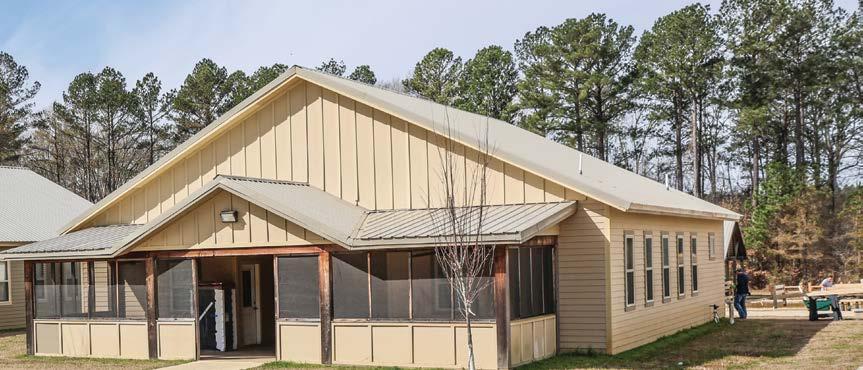






Kitchens visited 14 di erent special needs camps around the country.
“I took photos and asked questions. I wanted to find out what worked and what didn’t. Everything here comes from that,” Kitchens said.
Kitchens also hired Tanya Mohawk to be the camp’s executive director.
“You look around camp today, and everything you see are a bunch of miracles,” Mohawk said during a tour of the campground.
Jim Kitchens came up with the name.
“He said that special needs children have been through so much. They have to be so tough. Kamassa is a Choctaw word. It was perfect,” Kitchens said.
The foundation purchased 426 acres in Crystal Springs and paid it o by 2017. Construction on the camp started in 2018.
Military groups from all four branches came out over the years to work on the camp, Mohawk said.
Civil engineers and enlisted troops were sent to Camp Kamassa as part of the U.S. Department of Defense’s Innovative Readiness Training (IRT) program. The reservist training provides key services to American communities.
There’s nothing like Camp Kamassa in the state of Mississippi.
The cost of the camp is approximately $30 million.
When camp opens to the public this summer, Kamassa will have 14 cabins, a dining hall, a 14,000 square-foot medical clinic that can sta doctors and nurses, a recreation pavilion, a baseball and soccer field, a lake and lake house, a chapel, and an activity center where campers can participate in ceramics, woodworking, arts and crafts, music, and a dancehall.
There is also a wheelchair-accessible 3,000 square-foot pool for swimming.
The entire camp is wheelchair accessible.
Once Kamassa secures additional funding, they hope to feature other amenities including a rock-climbing wall in the activity center, a universal challenge course, an amphitheater, a general store, guided hunts, a farm, and an equestrian center.
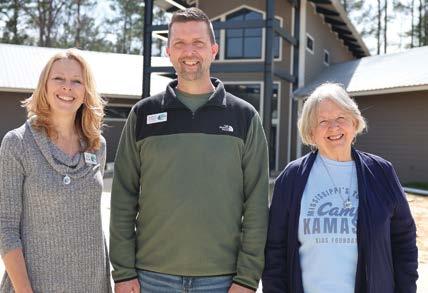
When Mohawk said the camp is filled with miracles wherever you look, she was referring to the work of volunteers and financial contributions of donors, organizations, and the state and federal government.
Southwest Electric, the Lorman-based electric cooperative, got involved with Camp Kamassa early.
Before any work could be completed at the site, they needed power. Southwest Electric provided poles, lines, and 3-phase power at no cost.
Since that time, Southwest employees have provided countless volunteer hours getting the camp ready to open. Employees also donate money to the project through a voluntary monthly paycheck deduction.
All 25 of Mississippi’s distribution electric co-ops and Cooperative Energy, a generation and transmission cooperative, made a collective donation to Camp Kamassa in the early stages of the venture.






Electric cooperatives live by seven Cooperative Principles. No. 7 is Concern for Community — “Cooperatives work for the sustainable development of their communities through policies supported by the membership.”
For Southwest Electric CEO and General Manager Kevin Bonds, getting involved was a no brainer.
“The project spoke to me. The mission really pulled at my heart,” Bonds said during a March volunteer workday at the camp.
During that workday, Southwest Electric employees built beds for the camp cabins.
“I’m getting excited because we are so close to seeing kids out here,” Bonds said.
Mohawk said Southwest Electric has become part of the Camp Kamassa family.
“We consider Southwest best friends,” Mohawk said.
“They (Southwest) went above and beyond for us and are an essential part of this camp community,” Kitchens said.








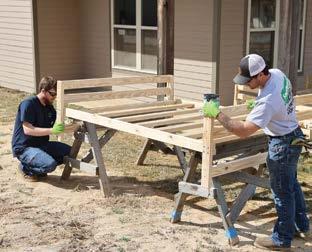


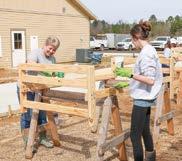













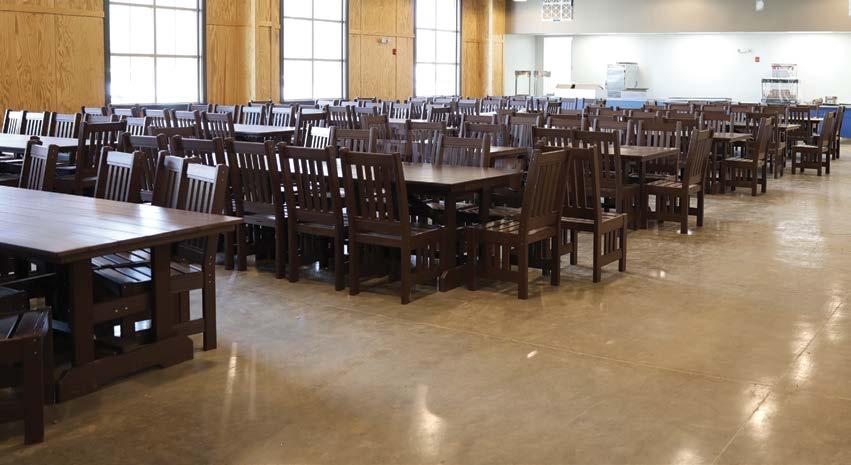






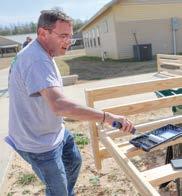

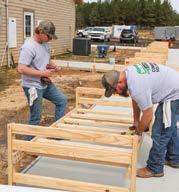
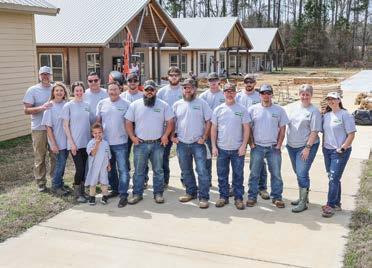



Andrew Vincent, the camp director, said Kamassa has a brain and spinal injury group coming for a session in the middle of May.
For the summer, seven weeks are already booked for five di erent groups including a Camp Rainbow group and a session for sickle cell patients.
Vincent said he hopes to get into partnerships down the road with UMMC Children’s Hospital and the Mississippi Schools for the Deaf and Blind. He also hopes to develop programming for the autistic population.
“This place has the capacity for so many opportunities in the future. I can’t wait to see what will be happening out here in 25 to 30 years,” Vincent said.





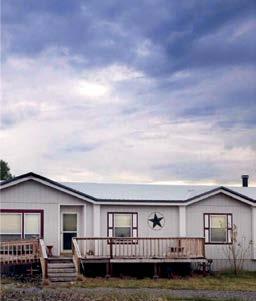

























by Scot Hoffman
National Rural Electric Cooperative Association (NRECA) CEO Jim Matheson brought a message of encouragement to electric cooperative leaders at the group’s annual PowerXchange meeting in Atlanta last month.
In his remarks during the opening session, Matheson drew upon the inspiring stories of the program’s early years as well as the impact of co-op vision, leadership and unity. He painted a picture of a co-op industry that is uniquely prepared to thrive.
We’ve connected the dots between economic growth and reliable, affordable, always-available electricity. The ironclad relationship between electricity and opportunity is something electric cooperatives demonstrate every single day.
“We strive to do the right thing, and we’re good at doing it,” he told the crowd. “In the face of hardship, we draw on the incredible foundation of character, courage and hope laid by those who came before us.”
Matheson called out the electric reliability threats caused by “bad public policy” as a major challenge of our time.
“Public policies haven’t planned for the growth in our economy and increases in electric demand the way they should have,” Matheson said. “That was our main message to the Biden administration, and it’s been our main message to the Trump administration.”
He noted that he, the NRECA team and co-ops across the country have worked together to quickly engage policymakers on ways they can help co-ops and rural communities succeed.
“We’re at the table. We have the relationships. We’re leaders because we know what it takes to bring power to the places that America depends on for its strength,” he said.
“We’ve connected the dots between economic growth and reliable, affordable, always-available electricity. The ironclad relationship between electricity and opportunity is something electric cooperatives demonstrate every single day.”
Matheson told the story of President Franklin Roosevelt’s summer home in Warm Springs, Georgia, dubbed the Little White House. It was there that FDR conceived the idea of creating the Rural Electrification Administration and entrusting rural Americans with the task of bringing power to the countryside.
“He knew what we could do,” he said. “He saw resilient men and women, forged by the experience of life in rural places, who could take on tough tasks, who possessed the self-reliance, the grit, the ability to work together to pursue an ambitious goal and then make it happen.
“And those attributes still ring true in rural America.”
Matheson also outlined the policy priorities co-ops are focused on in Washington, D.C. He listed key co-op objectives, including permitting reform, new power generation, continued investment in co-op infrastructure projects and a diversified national energy portfolio.
“When I talk about a pro-energy agenda for America, I’m talking about what we do best,” he said. “Pro-energy means local control. It means being practical. Pro-energy means being for something.”
“Our conversations this week help forge one, strong, powerful co-op voice. That’s the voice people hear in Congress, in the White House, in Washington and across the country,” he said.
“We make an incredible difference when we speak with one voice, choose the communities and people we serve, and when we put them first.”





































Sourdough bread has a dense texture and slightly tangy flavor. It is naturally leavened through fermentation using a “starter” from flour and water. People have made sourdough bread for thousands of years; however, during the 2020 pandemic, homemade sourdough exploded in popularity. Sourdough requires more care and attention than other breads, and once people have more time, they can nurture a starter and experiment with different loaves.
Constance Shelby, a registered dietitian, nutritionist, and founder of Perfect Fit Nutrition, began baking sourdough during the shutdown. “During COVID, my sister lived with us for a month. To make sure we didn’t lose our minds, she wanted to try sourdough,” Shelby said. “We spent forever growing the starter, but we were in heaven when we finally had that first loaf.”
Growing a sourdough starter isn’t hard, but it can be challenging because it requires patience and constant attention, nurturing through feedings, and keeping in a proper environment. Many homemakers feel a sense of connection with their starter and name it, making it part of the family.

Julie Richardson of Brandon is new to sourdough, but her starter is already part of the family. “We named the first starter, Marcus,” Richardson said. “Now we have Marcus Jr. because Marcus Sr. got moldy.”
Shelby offers a tip to anyone intimidated by growing a starter from scratch: “Order a dehydrated starter!” Shelby said. “You can be confident that your starter is good before baking. You can always grow a starter later once you’re comfortable.”
You can start baking when your starter consistently doubles in size within 4 to 8 hours after feeding, shows visible bubbles throughout, and has a slightly sour smell. Depending on your environment and flour type, it can take 1 to 2 weeks. Test the readiness of your starter by seeing if a small amount floats in a glass of water when added.
The next step is to get baking! Start with a simple bread loaf. But don’t forget that patience and resilience are essential ingredients when baking at home.
Sourdough bread elevates sandwiches with decadent fillings. It pairs well with soups, hearty stews, or creamy spreads, and it is well-suited for gourmet grilled cheese sandwiches.

4 cups bread flour (or all-purpose flour)
½ cup active sourdough starter (fed and bubbly)
2 teaspoons salt
1 ½ cups water (room temperature)
Mix the dough: In a large bowl, mix flour and water until just combined. Cover and let it rest for 30 to 45 minutes.
Add starter and salt: Add the sourdough starter and salt. Mix thoroughly by folding and stretching the dough.
Bulk fermentation (4 to 6 hours): Let the dough rest in a warm spot (~75 degrees). Perform 3 to 4 sets of stretch and folds every 30 minutes in the first 2 hours. Dough should double in size.
Shape the dough: Lightly flour a surface and shape the dough into a round or oval shape. Place it into a floured bowl with a towel seam-side up.
Final proof (8 to 12 hours in fridge): Cover with plastic wrap and refrigerate overnight. This helps with flavor and structure.
Bake the bread: Preheat oven to 475 degrees with a Dutch oven inside. Transfer dough onto parchment paper, score the top with a sharp knife, and place it in the Dutch oven. Cover and bake for 20 minutes, then uncover and bake for another 20 to 25 minutes until golden brown.
Cool and enjoy: Let the bread cool completely before slicing.

by Rebecca Turner
Rebecca Turner is an author, registered dietitian, radio host, television presenter, and board-certified in Lifestyle Medicine. She is A lifelong Mississippian and a member of the Central Electric Co-op in Brandon. Find her on social media @RebeccaTurnerTalks or online at RebeccaTurnerNutrition.com.





2 cups all-purpose flour
1 cup granulated sugar
2 teaspoons baking powder
½ teaspoon baking soda
1 tablespoon salt
1 tablespoon corn starch zest of half a lemon
1 cup blueberries



8 tablespoons butter melted
2 large eggs
½ cup sourdough starter discard
3 tablespoons sour cream or plain Greek yogurt
1 teaspoon vanilla extract
CRUMBLE TOPPING
3 tablespoons butter melted
½ cup granulated sugar
Crumb topping: Place the melted butter, flour, and sugar in a bowl and use a fork to mix until you have coarse crumble. Set aside.
Preheat your oven to 350 degrees. Line a 12-count muffin tin with paper liners or grease generously to prevent sticking.
Dry ingredients: In a large mixing bowl combine the flour, sugar, baking soda, baking powder, corn starch, lemon zest, and salt with a fork. Fold in blueberries. Set aside.
Wet ingredients: In a medium mixing bowl, whisk all the wet ingredients until smooth. Pour the wet ingredients into the dry ingredients and stir until just combined. (Add 1 to 2 tablespoons of water or milk if needed)
Divide the batter evenly into 12 muffins and top with the crumble topping gently pressing the crumble.
Bake for 30 to 35 minutes or until a toothpick inserted into the center of a muffin comes out clean. Let muffins cool in the tin for 10 minutes before removing to cool on a cooling rack.
Events open to the public will be published free of charge as space allows. Submit details at least two months prior to the event date. Submissions must include a phone number with area code for publication. Email to news@ecm.coop. Events are subject to change.
Dianne Holloman Memorial Farmer’s Market. April 5. May 3. June 7. Quitman. From 8 a.m. to 1 p.m. at the Quitman Depot, 100 South railroad Ave. The market will feature fruits and vegetables, home baked breads, honey, jams and jellies, crafts, homemade goods, and plants and garden items for sale. There will also be live entertainment and food vendors. Details: 601-776-5701.
GULFPEX 2025 Postage Stamp and Postcard Show. April 4 and 5. Biloxi. From 10 a.m. to 6 p.m. on April 4. From 10 a.m. to 4 p.m. on April 5. Hosted by the Gulf Coast Samp Club with support from Gulfport’s Traintastic S.T.E.A.M. Park and Model Railroad Museum. The show’s theme recognizes the return of AMTRAC to the Mississippi Gulf Coast with exhibits that will feature trains on postage stamps. Over 10 vendors from across the country will have stamps, postcards, albums, stamp supplies, and more for viewing and sale. From experienced collectors to beginners to those just interested in learning about collecting, there will be something for everyone. Free stamps will be available for kids and dedicated volunteers to show them how to organize and mount stamps in an album and to answer questions about stamp collecting. Opportunities for free stamp identifications, evaluations of collections, or sale of collections will also be available. Admission and parking are free. St. Martin Community Center, 15008 Lemoyne Blvd. Details: 228-238-5433.
Waynesboro Whistle Stop Festival. April 5. Waynesboro. From 10 a.m. to 4 p.m. This year’s festival theme is “Happy Trails.” The festival will include pony rides, food, arts and crafts vendors, the Barney and Marie Memorial Car Show, children’s train rides, space jumps, and many other activities. The downtown event is free. Details: 601-735-2268 or email librarywayne39367@gmail.com.
Spring Fling at Landrums Homestead. April 12. Laurel. From 9 a.m. to 4 p.m. 1356 Highway 15 South. Photos with the Easter Bunny, face painting, a scavenger hunt, games, a bunny cake hop, homemade ice cream, open smokehouse, wagon rides, and gem mining. Admission is $12. Children 3 and under are free. Details: 601-649-2546 or visit landrums.com.
Star Spring Festival for St. Jude Children’s Hospital. April 26. Star. From 9 a.m. to 1 p.m. 301 Mangum Dr. The event will feature a car, truck, bike, and tractor show, vendor and craft booths, a 5k walk/run, a kid’s fun run, a DJ, food, raffles, and an evening pageant. Admission is free for spectators. All registrations will 100% benefit St. Jude Children’s Hospital. Details: 601-842-7947 or visit starspringfestival.com.
Antiques and Collectible Barn Sale. May 2 and 3. Purvis. 4799 Old Highway 11 (Oak Grove area). From 7 a.m. to 5 p.m. More than 85 collectors with trailer loads of antiques, collectibles, advertising signs, glassware, railroad, wagon wheels, bells, primitives, anvils, crocks, advertising signs, furniture, tools, cast iron, tractor seats, old bottles, old windows and doors, jewelry, and coins. There will be a concession stand. Parking is $2 for both days. Details: 601-818-5886 or 601-794-7462.
Arts on Beulah Festival. May 3. Tylertown. Presented by the Walthall County Arts Council, the inaugural downtown festival begins at 10 a.m. and ends at 6 p.m. The festival will feature live entertainment, food and shopping opportunities, arts and crafts vendors, and a children’s activity area. The festival is looking for vendors to participate. Details: 504-458-4788 or email Susan.Appeldorn@walthallcountyarts.org.
“Safety

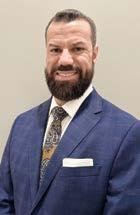

The Covington County Chamber of Commerce Annual Okatoma Festival. May 3. Collins. The downtown, free festival is held around the historic Courthouse from 8 a.m. to 7 p.m. The festival kicksoff with a 5-K run/walk and 1-mile children’s fun run. Activities include arts and crafts, food, a parade, antique car show, quilt exhibit, children’s park, health fair, and live entertainment featuring Jason Arnold and The Bird Dogs. Details: 601-765-6012 or visit covingtonchamber.com.
Bay Oaks Quit Show. May 9 and 10. Bay St. Louis. From 10 a.m. to 6 p.m. on May 9. From 10 a.m. to 5 p.m. on May 10. Quilts will be available for viewing. A raffle will be held on May 10 to win a quilt. The show is put on by the Bay Oaks Quilting Group. The show will be held at the St. Rose De Lima Community Center on Necaise Avenue. Details: 228-493-4678.
Harrison County Gem, Mineral, and Jewelry Show. May 17 and 18. Biloxi. From 9 a.m. to 5 p.m. on May 17 and 9 a.m. to 4 p.m. on May 18. The event will feature vendors, exhibits, and children’s activities. Jappa Shriner Center, 13280 Shriners Blvd. Admission is $6 for 12 and over. There is a $1 coupon on show’s website and Facebook page. Details: 601-947-7245 or 205-296-3779.
Gulf Coast Military Relics, Antique Arms, and Collectible Show. May 23 and 24. Biloxi. Historical military artifacts and relics from all periods and all wars bought, sold, and traded. Firearms, swords, daggers, bayonets, uniforms, helmets, medals, insignia, flags, books, photos, currency, old bottles, and other collectibles will be available. May 23 – 11 a.m. to 5 p.m. May 24 – 9 a.m. to 4 p.m. Joppa Shriners’ Center, 13280 Shriner’s Blvd. Admission is $7. Parking is free.
and



















Have you ever misplaced something you just had in your hand? That happened to me the other day. I was up early (well, early for me anyway) editing a story that had to air that afternoon on WJTV. When I finish editing a story, I always download it onto a thumb drive and transfer it to my laptop, from which I upload it to the TV station.



is a peck on the cheek — a short kiss. I’d rather have had a real dime, but I took what I could get.
I Googled “Yankee dime” to see if I could find out how the saying originated. Google was no help. I did find that the term seems to represent something that doesn’t have a lot of value. I assumed it was a saying from Mama’s childhood.
She’d
say,
“I’ll give you a Yankee dime if you’ll do so-and-so.” A Yankee dime is a peck on the cheek — a short kiss. I’d rather have had a real dime, but I took what I could get.
Now, it doesn’t take long for one of these little flash drives to start filling up. For instance, my current drive has all of my completed stories for about the past year and a half on it. Plus, all the raw video I shot on a trip we took to Europe a couple of summers ago. There’s also a lot of field footage from which I edit my finished stories. Needless to say, that little drive has grown quite important to me.
To shorten the story a bit, after I did the upload to the station, I had a shower, got dressed, and went to work. Later that afternoon I put my hand in my pocket to grab that drive, and it wasn’t there. I always keep that drive with me.
So, I went back to the parking lot to see if I dropped it when I got out of the car. No luck. I called Jo to go look in the driveway and see if I dropped it there.
Meanwhile, I was inventorying in my mind everything I’d be losing if I didn’t find that drive.
About that time Jo called me back and asked me what I’d give her if she found it. First thing that popped into my mind was a blast from the past. I told her if she found it, I’d give her a Yankee dime!
Now, I had not even heard that expression in decades, much less used it. Mama would o er me a Yankee dime if I took out the garbage or ran across the street and got something for her from the store. She’d say, “I’ll give you a Yankee dime if you’ll do so-and-so.” A Yankee dime
Jo found the missing drive in the pocket of the pajamas I was wearing that morning. I would have eventually found it myself. Well, maybe. Working at the house in my pajamas has its advantages. I just have to remember to check my pockets before I get dressed for work. Either that or convince Jo a “Yankee dime” is worth more than its face value.


by Walt Grayson
at walt@waltgrayson.com.





